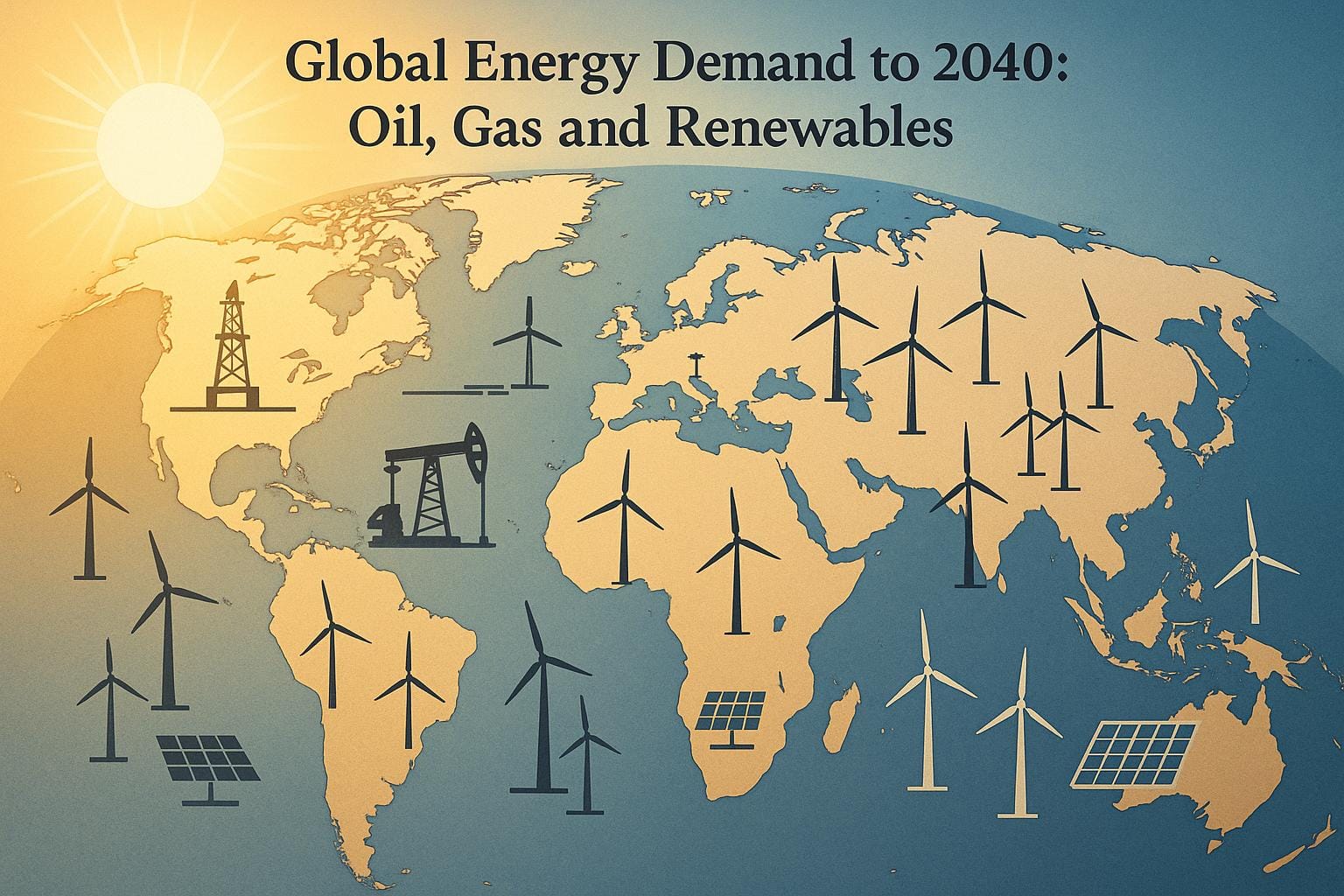Global Energy Demand to 2040: Oil, Gas and Renewables
Explore global energy demand projections through 2040, focusing on oil, gas, renewables, and the factors shaping the energy transition.

The global energy landscape is undergoing profound transformations. As populations grow, economies evolve, and technologies advance, the energy sector is poised for a dynamic yet challenging future. By 2040, global energy demand is expected to increase significantly, driven by economic growth and the ever-expanding need for electricity. However, the journey to meet this demand is complex, involving a delicate balance between energy addition and energy transition. Here's a comprehensive analysis of the trends, challenges, and opportunities facing enterprise and government decision-makers, with a focus on oil, gas, and renewables.
Growth in Global Energy Demand: The Big Picture
Between now and 2040, the world will require approximately 15% more energy than it does today. This translates into an increase of 100 exajoules over the next 15 years - roughly equivalent to the current energy consumption of the United States. Such growth underscores the monumental challenge of scaling up energy supply while simultaneously accelerating the shift toward cleaner energy sources.
Key Drivers of Demand
- Economic Growth: While global GDP growth is expected to slow from the current 3% to below 2% by 2040, the sheer expansion of industrial and consumer activities will drive higher energy needs.
- Technological Advancements: The rise of data-centric operations, including artificial intelligence (AI) and other high-power technologies, will amplify electricity requirements.
- Population Trends: Although population growth is decelerating, with fertility rates dropping in many industrialized nations, aging populations will shift energy consumption patterns.
Fossil Fuels: Resilience Amid Transition
Despite the accelerating uptake of renewables, fossil fuels - oil and natural gas - will remain dominant players in the global energy mix through the forecast period. However, their roles will evolve significantly.
Oil: The Transition to a Plateau
- Peak Oil Demand: Oil demand is expected to peak in the early 2030s at approximately 107–108 million barrels per day. Key factors driving the peak include the electrification of road transportation, particularly in China and Europe.
- Resilience Beyond the Peak: Post-peak, oil demand will plateau rather than decline sharply. By 2040, consumption is projected to remain above 100 million barrels per day due to continued reliance across multiple sectors, including petrochemicals and aviation.
- Sectoral Shifts: Road transportation accounts for 40% of oil demand today but will see a marked reduction as consumer vehicles increasingly transition to electric models.
Natural Gas: A Stable Growth Trajectory
- Continued Growth: Natural gas demand is set to grow strongly through the 2020s and early 2030s before plateauing in the latter half of the 2030s.
- Sectoral Demand: Gas will play a critical role in power generation and industrial processes, particularly as coal consumption declines.
- Buildings Sector Impact: Efficiency gains driven by heat pumps and improved building standards will curb gas demand in residential and commercial settings.
Renewables: The Accelerating Energy Revolution
The renewable energy sector is poised for unprecedented growth, with solar photovoltaic (PV) leading the charge. Its rapid adoption, driven by cost competitiveness and technological advancements, has positioned it as the cornerstone of the global energy transition.
- Solar PV Expansion: Solar PV is the fastest-growing energy source, gaining momentum worldwide, particularly in China, the "renewable superpower."
- Energy Storage: As solar and wind energy expand, investments in battery technology and energy storage solutions will be indispensable to manage grid stability and energy security.
- Coal’s Decline: Coal consumption is projected to halve by 2040, driven primarily by market forces rather than policy.
Wild Cards: Factors That Could Shift the Energy Landscape
Several variables could either accelerate or hinder global energy demand and the transition to renewables:
1. Geopolitical Fragmentation
- Rising geopolitical tensions and protectionist trade policies could disrupt energy supply chains, particularly for renewable technologies reliant on Chinese manufacturing.
- Countries prioritizing energy security may favor domestic coal or other resources over imported renewables, slowing the energy transition.
2. Demographic Shifts
- Slower population growth and an aging global population will reduce overall energy intensity. While older populations drive less, they consume more electricity for heating and leisure activities.
3. AI and Technological Disruption
- AI and digitalization could revolutionize energy efficiency, grid management, and autonomous systems, potentially reducing long-term energy demand.
- However, the immediate energy-intensive nature of data centers and AI infrastructure will drive significant electricity demand.
4. Economic Uncertainty
- Trade wars, tariffs, and economic slowdowns can suppress energy demand. However, thus far, recent trade disputes have had a limited impact on GDP and inflation.
Implications for GCC and Regional Stakeholders
For decision-makers across the GCC logistics, warehousing, and infrastructure sectors, as well as regional hyperscalers, the discussed trends have far-reaching implications:
- Strategic Energy Investments: Balancing energy security with the need for clean energy will require targeted investments in renewable infrastructure, particularly solar PV and storage solutions.
- Policy Frameworks: Governments should develop robust regulatory frameworks that encourage renewable adoption while ensuring energy resilience.
- Private Equity and Infrastructure Investments: Investors need to focus on assets that align with the dual goals of energy transition and energy addition, such as hybrid renewable-fossil projects and sovereign storage facilities.
- Technology Integration: Companies should leverage AI and digital tools to optimize energy use, enhance grid efficiency, and drive long-term cost savings.
Key Takeaways
- Global energy demand is expected to rise by 15% by 2040, necessitating a dual focus on energy addition and energy transition.
- Oil demand will peak in the early 2030s, but a plateau is likely to follow, ensuring continued relevance of oil and gas.
- Renewable energy, led by solar PV, will dominate new electricity generation, with storage solutions playing a critical supporting role.
- Coal consumption will decline significantly, largely driven by market dynamics rather than regulatory intervention.
- Demographics, trade policies, and technological advancements like AI will significantly influence energy demand patterns.
- Geopolitical tensions and protectionism pose risks to the energy transition, particularly in the renewable supply chain.
- AI has the potential to drive efficiency gains across the energy sector, though its immediate impact will increase electricity demand.
Conclusion
The world stands at the crossroads of rapid energy demand growth and a transformative shift toward renewables. For GCC countries and global stakeholders, the path forward requires balancing the resilience of fossil fuels with the acceleration of renewable energy adoption. By staying attuned to technological advancements, demographic trends, and geopolitical shifts, leaders can position their organizations to thrive in the evolving energy landscape. The energy transition is not just a challenge - it is a monumental opportunity to redefine the future of energy systems.
Source: "The future of global energy demand, with Claudio Galimberti and Jorge León" - Rystad Energy, YouTube, Sep 10, 2025 - https://www.youtube.com/watch?v=bjgUR88I-M0
Use: Embedded for reference. Brief quotes used for commentary/review.
